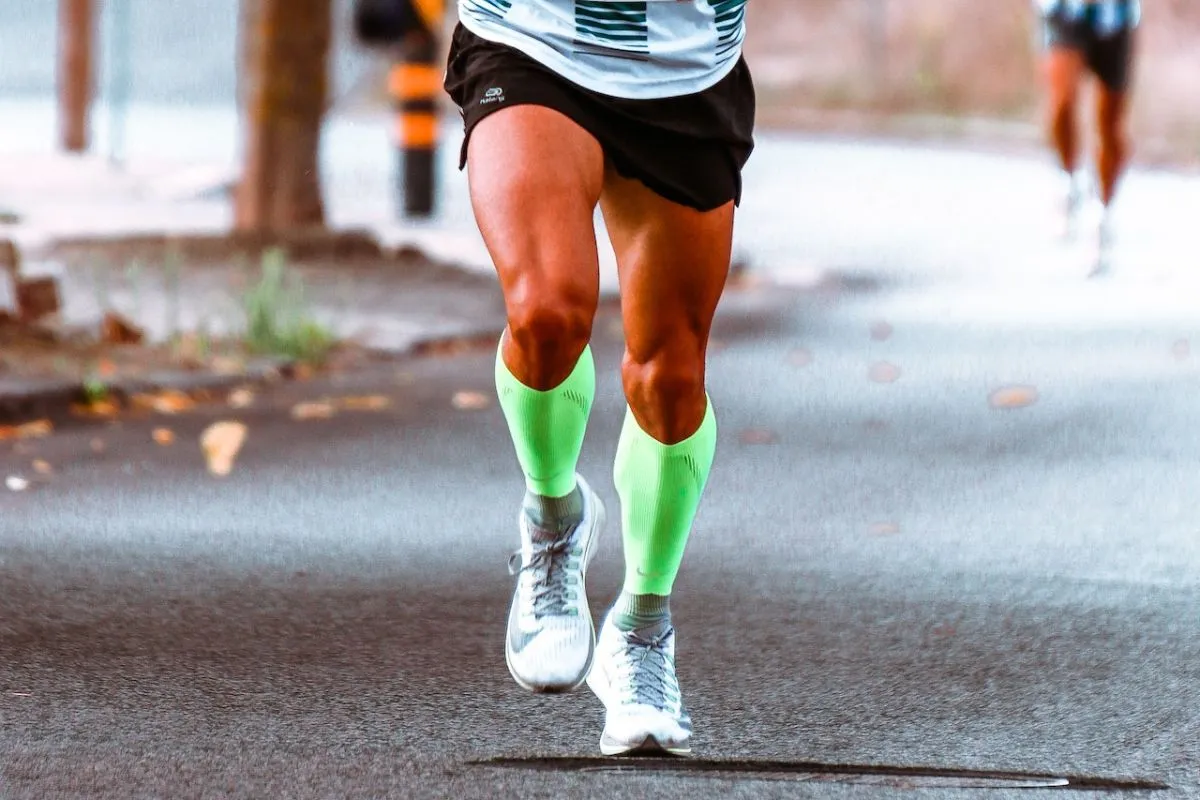The 3 Benefits of Running after Leg Day for Faster Recovery
Are you feeling tired after a hard leg day workout? Do you have questions about running after leg day? It is not uncommon to feel exhausted and need a few extra few hours of rest, but did you know that running the day after leg day can actually help your body recover faster?
Should you run on leg day? What are the benefits of doing so? In this article, we will explore the benefits of running after leg day and how it could potentially speed up recovery and result in added muscle gain. Keep reading to learn all about balancing running and lifting!
Is running after leg day bad for you?
Running after leg day helps athletes speed up muscle recovery, increase fat burning, and strengthen their cardiovascular systems. Weightlifting exercises such as squats, lunges, and deadlifts help improve strength, power endurance, and running performance. Runners should also integrate stretching before and after workouts in order to facilitate proper blood flow around targeted muscles.
What Is Leg Day and Why Is It Important for Runners?
Leg day is a day focused on the lower body muscles, emphasizing exercises such as squats, lunges, and calf raises. Runners need leg day training to strengthen their lower body muscles and improve overall running performance.

This type of training is important because it helps build strength, power, and speed in the legs, which are essential for efficient running technique. Leg day also strengthens the tendons connected to each muscle, providing improved stability.
For some runners, leg day can be especially difficult to recover from, due to the heavy load placed on the legs. Running before or after weights can result in muscle damage and DOMS, which is characterized by an aching or burning sensation that typically peaks 24-48 hours post-workout. High-intensity runs after leg day may lead to additional muscle damage, causing further fatigue and difficulty when it comes time to run again in the future.
After a leg day workout, your legs will have increased volume and stiffness due to increased blood flow. This is because lower limbs experience greater force during strength training than they normally do during aerobic running activity. You can expect an increase in leg size, accompanied by increases in blood flow and collagen, which help to improve the body’s response to exercise and reduce fatigue.
What Can Leg Day Include?
Leg day is an essential part of a runner’s routine for increasing leg strength and power. It includes exercises that involve working multiple muscle groups of the legs, such as the quads, hamstrings, glutes, and calves.
Common examples include:
- Squats, lunges, step-ups, or stair climbing to work on the quads.
- Deadlifts and Romanian deadlifts to target the hamstrings.
- Hip thrusts to work on both your glutes and lower back muscles.
- Calf raises to build up calf muscles.
- Sprinting outdoors or using a treadmill machine.
To be able to perform optimally during a run, it is important to make sure all major muscle groups in the legs are targeted with specific exercises.
3 Benefits of Running After Leg Day
Running after leg day has 3 main benefits. Read on to discover how running can help optimize your workouts.

1. Faster Recovery
Running after a tough leg day is a great way to help speed up recovery and promote muscle growth. When runners hit the pavement following leg day, they benefit from increased blood flow around the targeted muscles.
Taking an active approach helps reduce the buildup of lactic acid, which in turn reduces soreness and prevents fatigue-related injuries. In addition, running with proper form encourages oxygen delivery throughout the body’s muscle tissues and helps reduce inflammation and swelling.
2. Stronger Cardiovascular and Respiratory Systems
By improving circulation, oxygen levels, and lung function, running offers many benefits that can improve your overall health. Running after leg day helps increase the supply of necessary nutrients to tired muscles while also removing metabolic waste.
Running has been linked to better oxygen intake, helping with deeper breaths and more efficient respiration after a strenuous workout. It also improves lung capacity, which is essential for long-duration exercise activities, such as marathons and triathlons.
3. Increased Fat Burning
When you combine weight training and running, your muscles become more metabolically flexible. This helps them increase their capacity to oxidize fats during exercise and increases overall endurance.
Combining running with strength training can give runners beneficial changes in their body composition. Higher energy expenditure leads to an increased ability to oxidize fat over time, allowing for greater fat loss.
Is It Bad to Run After Leg Day? 2 Disadvantages
Running after leg day has 2 potential disadvantages: increased risk of injury and overtraining.
1. Increased Risk of Injury
Running before or after a leg day, especially high-intensity runs, can cause damage to the muscles while they are still in recovery mode. This is because your lower body muscles have not fully recovered from the previous workout, and running can make them vulnerable to muscle strain. This is why it’s essential for runners to pay close attention to their bodies when balancing leg day with their regular runs.
2. Potential Overtraining
Running too much after leg day can also lead to overtraining, a condition where muscle fatigue and soreness become persistent. Without enough rest between workouts for your muscles to recover and repair, continual exercise can result in long-term damage or injury.
Overtraining symptoms are often not evident at first, but when they are left unchecked they can ultimately decrease performance. If you’re running after weightlifting, listen to your body carefully. Any signs of exhaustion should be addressed with additional rest days in order to prevent potential overtraining.
Subscribe to Our Running Newsletter!
Get free running tips from renowned professional athletes and discounts from top-notch brands.
How to Run Properly After Leg Day
Intense running the day after a leg workout is not always optimal, and in some instances can even harm you. It’s important to give your muscles and joints enough time to recover before an active running workout.

Pro Tip:
The exact amount of time that should be taken depends on factors like running intensity, overall fitness level, individual performance, and previous history of injuries or fatigue. Generally speaking, 24-72 hours is usually sufficient to allow for adequate muscle repair.
It’s best to initially start with low to moderate-intensity running, or even go for an easy jog before increasing in speed and length. This will ensure muscles have enough time to properly recover from leg day.
Recovery is just as important as exercise. Try foam rolling and follow a good nutrition strategy to speed up recovery time.
Here are 2 simple tips to help you combine running and strength training.
1. Proper Stretching Before and After
Both before and after leg day, it’s crucial to stretch in order to maximize the recovery process and minimize any risk of injury.

Pro Tip:
Before strength training, you should do dynamic stretching to prepare your muscles for the coming session. After training, you should perform static stretching. Avoid putting strong pressure on the muscles that were worked during the workout.
Stretching both before and after a workout will help protect against tight muscles, which can lead to strains or pulls. This is especially important on hard days like leg day.

2. Maintaining Glycogen Stores
Glycogen is a form of sugar stored in the muscles that fuels your runs, giving you energy during and after exercise. It’s important to replenish these stores, as depleted glycogen can lead to fatigue and decreased performance.
Consuming carbohydrates after leg day helps refuel muscle glycogen levels more efficiently. Post-leg workout recovery should also include foods with high protein content, such as nuts, meat, fish, and eggs.
Is It Better to Run Before or After Lifting?
Should you run first or lift first? As it turns out, there is a difference in how other activities, such as weight training, can impact different types of running. For example, running after a strength training session can have implications on endurance and performance. If you are wondering should I run after leg day, here are the benefits and risks of running before and after lifting.
Benefits and Risks of Running Before Weightlifting
Running before weightlifting can be an effective way to warm up and prepare your body for the workout ahead. However, there are potential risks to consider when running and lifting the same day.
Benefits of Running Before Weightlifting:
- Improved Endurance: Running as a warm-up activity can enhance your overall endurance, allowing you to perform weightlifting exercises more effectively.
- Better Performance: A proper running warm-up can lead to improved performance in your weightlifting routine, helping you lift heavier weights or complete more repetitions.
- Enhanced Energy Expenditure: Running increases your heart rate and blood flow, potentially leading to increased calorie burn during your weightlifting session, which can be beneficial for weight management goals.
Risks of Running Before Weightlifting:
- Muscle Fatigue: Running before weightlifting can lead to muscle fatigue, potentially compromising your strength and muscle-building capacity during weightlifting exercises.
- Negative Impact on Technique: High-intensity runs immediately before weightlifting can affect your form and technique, increasing the risk of injury and hampering your lifting progress.
Benefits and Risks of Running After Weightlifting
Running after a weightlifting session, particularly after a strenuous workout, can provide a range of potential fitness benefits. This post-weightlifting practice is often lauded for its positive effects on muscle recovery, soreness reduction, and fat burning. However, it’s crucial to be aware of certain risks that can arise, especially on days when the body is fatigued due to intense weightlifting. Let’s explore these benefits and risks in more detail.
Benefits of Running After Weightlifting:
- Enhanced Muscle Recovery: Running after weightlifting increases blood circulation to recently exercised muscles, aiding in muscle recovery by delivering oxygen and removing waste products like lactic acid.
- Soreness Reduction: Low or moderate-intensity post-exercise runs are believed to help reduce muscle soreness, potentially making recovery more comfortable.
- Fat Burning: Incorporating regular cardiovascular activities like running into your post-weightlifting routine can help burn fat, contributing to improved overall fitness.
Risks of Running After Weightlifting:
- Increased Fatigue: Running after intense weightlifting, particularly on leg day, can lead to accumulated fatigue and an elevated risk of injury or overtraining if pushed too hard.
- Risk of Overuse Injuries: Repeatedly engaging in running immediately after weightlifting sessions can raise the risk of overuse injuries, such as stress fractures or tendonitis, due to the additional strain on already fatigued muscles and joints. It’s important to monitor your body’s signals and avoid excessive or high-impact running under such conditions.
Frequently Asked Questions About Running the Day After Leg Day
Is It Better to Run or Cycle After Leg Day?
Both running and cycling after leg day have benefits. Running promotes improved cardiovascular fitness, increases calorie expenditure, and helps reduce muscle soreness. On the other hand, cycling results in less impact on the legs, so it may be a better choice if DOMS is an issue.
Is It OK to Jog After Leg Day?
Jogging after a leg day workout can be especially beneficial for muscle recovery. However, if you are feeling too sore or exhausted, then it may be better to rest until fully recovered before attempting any further physical activity.
How Do You Balance Leg Day and Running?
Runners aiming to get the most out of their leg days while remaining safe on their recovery runs need to monitor their training intensity. After leg day, focus on moderate running that is slower and easier than normal. This allows for proper recovery without putting additional strain on weakened muscles.
Final Thoughts on a Run Before or After Leg Day
One of the most important aspects to consider when it comes to running after leg day is timing. It’s important to allow enough time for recovery before engaging in high-intensity running, especially if intense leg exercises were performed.
A 48-hour window between a heavy leg day and a high-intensity run ensures that muscles can recover optimally without risking any potential injury or burnout. On the other hand, low-intensity runs can typically happen straight after a leg session.
No matter what type of activity you choose, consistency, discipline, and listening to your body will all help you maximize performance.
Do you prefer running before or after leg day? Please share your experience in the comments below.
Also Read:
What to Eat the Night Before a Long Run
Why Are Running Shorts So Short
How Much Jump Rope Is Equivalent to Running a Mile
Cardio Alternatives to Running
Can You Run a Marathon With No Training
Benefits of Sprinting
Best Running Shoes for Concrete
How Long Is a 15K
References:
- Vikmoen O, et al. Effects of Heavy Strength Training on Running Performance and Determinants of Running Performance in Female Endurance Athletes. PLoS One. 2016 Mar 8;11(3):e0150799. https://journals.plos.org/plosone/article?id=10.1371/journal.pone.0150799
- Joyner MJ, et al. Regulation of increased blood flow (hyperemia) to muscles during exercise: a hierarchy of competing physiological needs. Physiol Rev. 2015 Apr;95(2):549-601. https://journals.physiology.org/doi/full/10.1152/physrev.00035.2013
- Prieto-González P, et al. Effects of Running-Specific Strength Training, Endurance Training, and Concurrent Training on Recreational Endurance Athletes’ Performance and Selected Anthropometric Parameters. Int J Environ Res Public Health. 2022 Aug 29;19(17):10773. https://www.mdpi.com/1660-4601/19/17/10773
- Schumann M, et al. Compatibility of Concurrent Aerobic and Strength Training for Skeletal Muscle Size and Function: An Updated Systematic Review and Meta-Analysis. Sports Med. 2022 Mar;52(3):601-612 https://link.springer.com/article/10.1007/s40279-021-01587-7
- Page P. Current concepts in muscle stretching for exercise and rehabilitation. Int J Sports Phys Ther. 2012 Feb;7(1):109-19. https://www.ncbi.nlm.nih.gov/pmc/articles/PMC3273886/
If you have any questions or suggestions, you can contact us via email – [email protected]






